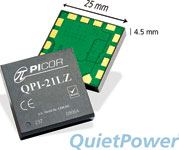EMI filter for DC-DC converters
2 May 2012
Circuit & System Protection

Vicor announced the introduction of the Picor QuietPower QPI-21 active EMI filter for DC-DC converters. Supporting 48 V DC-DC converter designs up to 14 A for data communications and telecommunication applications, the device provides >99,5% efficiency while achieving high filtering performance.
The QPI-21 is packaged in a high-density, 25 x 25 mm land grid array (LGA) surface mount package. Its 4,5 mm height maximises airflow for space constrained designs, making it an ideal fit for advanced blade-architecture applications. These density advantages are complemented by new performance enhancements enabling higher-frequency attenuation across various system configurations than earlier-generation QuietPower QPI-series filters.
The device attenuates conducted common mode (CM) and differential mode (DM) noise over the CISPR22 frequency range of 150 kHz to 30 MHz (45 dB for CM and 80 dB for DM attenuation at 250 kHz). It is designed for use in 48 V bus (36–76 V) systems, with 100 V d.c./100 ms surge capability, and operates over a wide temperature range of –40°C to +125°C and up to an ambient temperature of
65°C without derating.
The QPI-21 supports the PICMG 3.0 specification for filtering system boards to the EN55022 Class B limits and is also tolerant to all DC-DC converter grounding schemes. It addresses multiple voltage rail/bus needs for applications in aerospace and industrial, in addition to datacom and telecom. The device is a universal filter for use with DC-DC converters from any manufacturer.
Further reading:
Smarter protection without disruption
NewElec Pretoria
Circuit & System Protection
Designed for operations still running without integrated automation, NewElec’s retrofit-friendly systems let you upgrade performance and safety without overhauling your entire network.
Read more...
Circuit breaker for reliable, compliant protection
RS South Africa
Circuit & System Protection
Legrand’s low-voltage power distribution portfolio encompasses the DX3 range of miniature circuit breakers, designed to deliver dependable protection in residential, commercial and industrial installations.
Read more...
Reducing noise on power supply lines
Future Electronics
Circuit & System Protection
Murata has introduced the EMIFIL ESD Series Noise Filters, a breakthrough solution engineered for superior noise suppression and enhanced electrostatic discharge (ESD) protection.
Read more...
Clearing the Static: Fundamental principles of static control
Actum
Circuit & System Protection
Controlling electrostatic discharge in electronics manufacturing is essential with effective ESD programs built on six key principles.
Read more...
Electrical fire safety in lithium-ion battery rooms
Circuit & System Protection
Pratliperl is a non-combustible, ultra-lightweight aggregate that can be mixed with cement and applied as a plaster or screed to walls, floors, and ceilings.
Read more...
Clearing the Static: ESD training in the workplace
Actum
Circuit & System Protection
To protect sensitive electronic components, A structured, consistent, and sustainable ESD training program is essential.
Read more...
Protect your pumps – protect your profit
NewElec Pretoria
Circuit & System Protection
In South Africa’s demanding agricultural landscape, irrigation is not just an essential service – it is the heartbeat of farm productivity.
Read more...
Clearing the Static: ESD and installation: A durable antistatic solution
Actum
Circuit & System Protection
ESD flooring provides a reliable, long-term solution for managing static electricity by safely dissipating static charges through the floor to a designated ground point.
Read more...
Why wait to automate
NewElec Pretoria
Circuit & System Protection
NewElec’s initiative helps you gain operational visibility via HMI or PLC by retrofitting intelligent motor protection relays without replacing MCCs or rewiring the plant.
Read more...
Clearing the Static: Effectively control static in your workplace
Actum
Circuit & System Protection
Controlling electrostatic discharge in the workplace is crucial to protect sensitive electronic equipment from damage. Implementing an ESD control program involves various measures and tests.
Read more...


